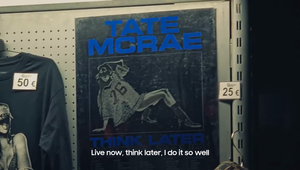
New We Are Social Report Identifies Emerging Trends and the Creators Driving Them

The Next Gen Influence report sets out five trends defining a new era of brand and creator collaboration. It describes what’s driving them and the implications for brands, featuring examples from the likes of Booking.com, H&M, and more.
Within each trend, the agency has identified a cohort of fast-growing creators that represent the next generation of influence. These range from Aslan Pahari, a Gen-Z history creator on TikTok who uses his platform to challenge our understanding of history, to John Pork, an AI-enhanced Travel Influencer who happens to be a pig.
The Next Gen Influence trends are:
The Right to Reinvention: Social loves a ‘journey’, but in today’s creator economy, this focus on the journey has complicated our idea of authenticity. Authenticity used to require consistency, but today – with child influencers growing up, and mainstays ageing out – audiences are used to watching people change. In this context, creators are planning their evolutions to draw in new viewers.
Featured creator: Lucinda Price aka froomes has evolved from a young woman chasing the spotlight to a multifaceted entertainer and writer. She's won audiences over by candidly sharing her journey of self-reinvention, navigating challenges like disordered eating and mental health issues, and shifting her focus toward connection, humour, and self-acceptance.
Relatable Realism: Aspirational content is the bread and butter of influence. But today – with most people striving for stability, not luxury – aspiration is having to change shape to stay realistic. Now, creators peddling ‘the good life’ are having to reappraise what that life looks like to make it feel relevant for real people. This means lifestyle content that’s less about glamour and luxury, and more about calm and stability.
Featured creator: Sarah Rani, a hobbyist gardener turned educator, is on a mission to help one million people grow their own food. Her content feels relatable and inspiring to audiences looking for alternatives to consumption-driven urban lifestyles, offering practical guidance on self-sufficiency and sustainable living.
Influential Allies: In recent years we’ve seen creators engage in acts of altruism to demonstrate their ethical credentials – a trend embodied by Mr. Beast's loud charitable endeavours. But in this context, there’s increasing concern that philanthropy is being used for the purpose of online clout. As audiences become sceptical of moral posturing, creators are swapping work that claims values for work that actively disrupts or challenges the status quo.
Featured creator: Aslan Pahari, a Gen-Z History creator on TikTok, uses his platform to challenge and educate through the analysis of overlooked moments in history as well as reacting to other creators claims – who first traded with Indigenous Australians to the origins of South Asian people as well as why Australians say ‘Naur’ over no.
Credible Creativity: On today’s social channels, a new wave of culturally impactful creativity is thriving, driven forward by creators who’ve mastered ‘very online’ modes of communicating. These approaches – from making work inspired by fanfic to repackaging vulnerability as entertainment – are pushing the creative bar higher for everyone, but especially for brands, who have to be as entertaining as their human counterparts, but without the same licence for imperfection or human charm attributed to real people.
Featured creator: Passion and fan experiences are at the heart of online creativity. Kayo Sports taps into this by working with creators like Rachid Elmerkaoui, a well-known sports fan whose first-person perspective resonates with fellow enthusiasts. Through his content, Kayo provides exclusive access to fan-driven moments, allowing viewers to experience the excitement of sports through the eyes of a true fan.
Extreme Influence: The ‘dead internet theory’ is one of many laments of how bots, trend cycles, and garbage content have thrust online creativity into crisis. For today’s creators – who find themselves wading through a sea of content that’s loud and fast-moving, but often lacking in creative merit – it’s difficult to stand out. As the next generation of creators navigate this space, they’re leaning into the unusual and extreme, trying to break the internet's unspoken rules to make an impact.
Featured creator: To combat this sea of sameness, creators like Nedd Brockman are pushing the broad space of sports content to its furthest extreme, with lo-fi, relatable, and yet inspiring content showcasing elaborate feats of human achievement.
To identify the trends, We Are Social conducted a mixed-methodological approach to analysing influence, using quantitative, qualitative, and cultural analysis. Through contextual desk research, expert interviews, and using influencer identification platform Tagger to identify recent fastest-growth creators, its Cultural Insights department used thematic analysis to identify five emergent trends shaping the influencer marketing category.
Suzie Shaw, CEO at We Are Social Australia, said, “Our creator landscape is more vibrant than ever, and having worked with creators for the past 15 years, we’ve seen firsthand how they can really shape culture and build brands. It's exciting to witness their increasing ability to engage audiences with content that not only entertains but adds real value to people’s lives, making them important partners for marketers. As the creator landscape continues to evolve, the opportunities for brands to connect authentically and meaningfully with audiences will only grow, driving real impact."
Mobbie Nazir, global chief strategy officer at We Are Social commented, “The creator economy is growing rapidly, driven not only by platforms but by the individuals working in those spaces. They are finding ever more creative and distinct ways to engage audiences at scale. In this continuously evolving ecosystem, keeping up with the latest movements can be hard for brands. Our Next Gen Influence report maps out not just the surface-level shifts, but the deeper motivations impacting brand-creator collaborations in the long term."
The full report is available to download on We Are Social’s website.















